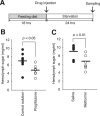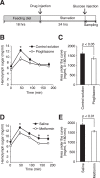Diabetic silkworms for evaluation of therapeutically effective drugs against type II diabetes
- PMID: 26024298
- PMCID: PMC4448660
- DOI: 10.1038/srep10722
Diabetic silkworms for evaluation of therapeutically effective drugs against type II diabetes
Abstract
We previously reported that sugar levels in the silkworm hemolymph, i.e., blood, increase immediately (within 1 h) after intake of a high-glucose diet, and that the administration of human insulin decreases elevated hemolymph sugar levels in silkworms. In this hyperglycemic silkworm model, however, administration of pioglitazone or metformin, drugs used clinically for the treatment of type II diabetes, have no effect. Therefore, here we established a silkworm model of type II diabetes for the evaluation of anti-diabetic drugs such as pioglitazone and metformin. Silkworms fed a high-glucose diet over a long time-period (18 h) exhibited a hyperlipidemic phenotype. In these hyperlipidemic silkworms, phosphorylation of JNK, a stress-responsive protein kinase, was enhanced in the fat body, an organ that functionally resembles the mammalian liver and adipose tissue. Fat bodies isolated from hyperlipidemic silkworms exhibited decreased sensitivity to human insulin. The hyperlipidemic silkworms have impaired glucose tolerance, characterized by high fasting hemolymph sugar levels and higher hemolymph sugar levels in a glucose tolerance test. Administration of pioglitazone or metformin improved the glucose tolerance of the hyperlipidemic silkworms. These findings suggest that the hyperlipidemic silkworms are useful for evaluating the hypoglycemic activities of candidate drugs against type II diabetes.
Figures







Similar articles
-
An invertebrate hyperglycemic model for the identification of anti-diabetic drugs.PLoS One. 2011 Mar 30;6(3):e18292. doi: 10.1371/journal.pone.0018292. PLoS One. 2011. PMID: 21479175 Free PMC article.
-
Angiotensin II receptor blocker telmisartan prevents new-onset diabetes in pre-diabetes OLETF rats on a high-fat diet: evidence of anti-diabetes action.Can J Diabetes. 2013 Jun;37(3):156-68. doi: 10.1016/j.jcjd.2013.03.024. Epub 2013 May 29. Can J Diabetes. 2013. PMID: 24070838
-
A hyperglycemic silkworm model for evaluating hypoglycemic activity of Rehmanniae Radix, an herbal medicine.Drug Discov Ther. 2016 Feb;10(1):14-8. doi: 10.5582/ddt.2016.01016. Epub 2016 Feb 19. Drug Discov Ther. 2016. PMID: 26902904 Review.
-
Evaluation of anti-diabetic drugs by using silkworm, Bombyx mori.Drug Discov Ther. 2016 Feb;10(1):19-23. doi: 10.5582/ddt.2016.01017. Epub 2016 Feb 22. Drug Discov Ther. 2016. PMID: 26961328 Review.
-
Pioglitazone versus metformin in two rat models of glucose intolerance and diabetes.Pak J Pharm Sci. 2010 Jul;23(3):305-12. Pak J Pharm Sci. 2010. PMID: 20566445
Cited by
-
Nature's blueprint for sugar metabolism: translating bee and ant strategies into human diabetes therapies.Diabetol Metab Syndr. 2025 Jun 7;17(1):200. doi: 10.1186/s13098-025-01755-z. Diabetol Metab Syndr. 2025. PMID: 40483521 Free PMC article. Review.
-
Silkworm, Bombyx mori, as an alternative model organism in toxicological research.Environ Sci Pollut Res Int. 2018 Dec;25(35):35048-35054. doi: 10.1007/s11356-018-3442-8. Epub 2018 Oct 29. Environ Sci Pollut Res Int. 2018. PMID: 30374720
-
Effect of black ginseng and silkworm supplementation on obesity, the transcriptome, and the gut microbiome of diet-induced overweight dogs.Sci Rep. 2021 Aug 11;11(1):16334. doi: 10.1038/s41598-021-95789-8. Sci Rep. 2021. PMID: 34381138 Free PMC article.
-
The Impact of Diabetes on Male Silkworm Reproductive Health.Biology (Basel). 2024 Jul 24;13(8):557. doi: 10.3390/biology13080557. Biology (Basel). 2024. PMID: 39194495 Free PMC article.
-
Advances in Editing Silkworms (Bombyx mori) Genome by Using the CRISPR-Cas System.Insects. 2021 Dec 27;13(1):28. doi: 10.3390/insects13010028. Insects. 2021. PMID: 35055871 Free PMC article. Review.
References
-
- Kahn B. B. Type 2 diabetes: when insulin secretion fails to compensate for insulin resistance. Cell 92, 593–596 (1998). - PubMed
Publication types
MeSH terms
Substances
LinkOut - more resources
Full Text Sources
Other Literature Sources
Medical
Research Materials

